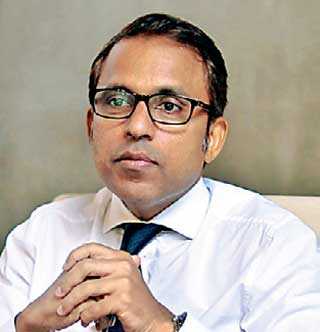Friday Dec 13, 2024
Friday Dec 13, 2024
Thursday, 24 January 2019 02:05 - - {{hitsCtrl.values.hits}}
Being in business for over 21 years, Just in Time Group (JIT), hit yet another milestone in the Sri Lankan tech landscape by enabling People’s Bank through its digitisation process. An exercise that began in 2015 with the building of the necessary infrastructure, a growing number of People’s Bank branches are now complete ‘digital branches’ that allow customers to be fully on board with all services without actually having to visit the branch which increases the ease of access to the bank’s services.
 |
Just In Time Group CEO Chrishan Mendish |
 |
Peoples Bank Head of IT Priyantha Edirisinge |
“The partnership with People’s Bank was a decision that was easily made, as JIT already had a proven record of accomplishment with the bank that began 18 years ago with the ATM Switch Project. As our relationship was already formed, moving forward therefore was easier as JIT already understood the bank’s processors and protocols – where ‘efficiency and fluidity’ was a key aspect for the digitisation process implemented from both ends,” said JIT CEO Chrishan Mendis.
One of the most important outcomes of this digitisation process is the change in the role of the bank branch itself. While there are currently 150 digital branches across the country, each branch will have three digital agents capable of onboarding customers and providing loan facilities. The digital branch will also allow customers to make cash deposits, fund transfers and pay bills. The branch itself is being looked at as an ‘investment centre’ that will enable customers to make more financially informed decisions.
Having taken nearly three and a half years, the digitisation process began with the deploying of the system, which took nearly a year. Following which, the subsequent two and a half years were spent on work to ensure that the deployment went smoothly. Digitising each service of People’s Bank included a task force comprising JIT team, more than hundred staff from the bank itself and other stakeholders in this process.
The digitisation of the People’s Bank comes at a pivotal time. As one of the first banks in Sri Lanka to imbibe a holistic digitisation, the achievement is a lauded one, as most government institutions come with considerable protocols and procedures.
Building the necessary infrastructure was key. Yet, despite JIT offering the right platform, digitising People’s Bank wasn’t something that happened overnight. “It’s not simply bringing a platform and plugging it in,” said Chrishan. Sandalal Edirisinghe Head of IT at the Bank shared that digitising each service of People’s Bank was a monumental task. Each time, this involved 100s of people from the bank, JIT, Silverlake the principal, and many more. There were countless discussions that took place between these people. This was because the business processes behind these services had to operate smoothly once digitised.
“Everything that you do, from Facebook, hotel bookings, happens digitally. It is your life partner. As a bank if you don’t have your services through this channel, then there’s no digitisation,” said Sandalal Edirisinghe. This is why the bank embarked on a drive to digitise its operations with the support of the JIT.
Since the project has gone live, the impact of digitisation on People’s Bank is exponential, Sandalal proudly stated, “Our teller traffic has reduced by 60%!” He goes onto explain that previously people lined up at tellers to pay bills, make deposits, and transfer funds. But now the Cash Deposit Machines allow customers to make deposits and transfer funds. He added that People’s Bank saw Rs. 30-40 million deposits being made through these machines. Meanwhile, bills can be paid via ATMs.
Typically, it takes 2-3 days he says with multiple forms to fill, but now with the digitisation process, at the digital branches where their digital agents are stationed, all you need is your NIC to complete this process. Once you show your NIC, the digital agents capture all your information on a tablet. Then the system creates your account and issues a debit card. After that, you can visit a cash deposit machine to deposit money into your account, following which you will get a sms informing you of your deposit. Thereafter you are ready to withdraw cash or pay your utility bills by any mode.
“Within 10-15 minutes you become an end to end customer. You’re accessing your account, paying your bills, and you walk out. Every service is enabled and you only need to bring your NIC. With traditional banking, you need 2 to 3 days. Going forward, you won’t need to come to a branch,” Sandalal shared. This is because the People’s Bank mobile app would offer e-statements, fund transfers, and bill payments. “Two weeks from the launch, we’ve gotten 150,000 customers,” stated Sandalal with regards to the app. He also added that the total value of transactions with the app was at Rs. 7 billion. In comparison, the old SMS service by People’s Bank has 800,000 customers but their transactions were worth only Rs. 1 billion.
This is the experience and efficiency all their customers will receive from People’s Bank Digitisation, which continuously will be enhanced with further value additions for their customers, for which JIT is committed to giving their full support to ensure this vision is sustained successfully.
JIT commenced operations in 1996 as a single entity in a 100sq ft. basement office – a journey which started over 21 years ago, has been one of success and learning. Since its humble beginnings, JIT has grown from a team of four members to a group of 290 employees with varied Information and Communications Technology (ICT) offerings ranging from systems integration to Geographical Information Systems (GIS). Furthermore, JIT was the only local company recognised in the APAC CIO Outlook magazine’s Annual Top 25 Government and Public Sector Technology Providers for 2017. With over two decades of excellence, JIT provides cutting-edge integrated solutions to telecommunications, government, health, defence, and financial sectors.